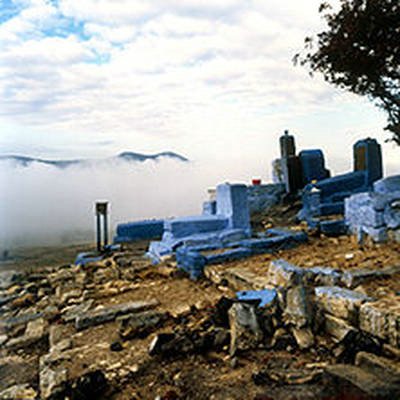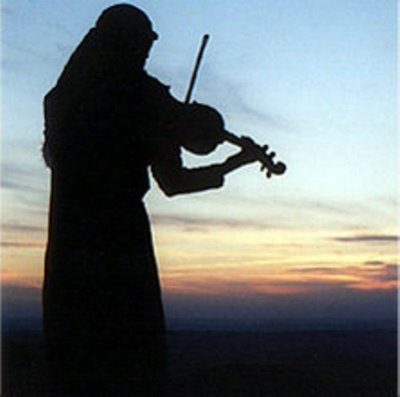Monday, September 18, 2006
The Niggun that Saved a Soul Centuries Later
Today is the 25th of Elul, the 220th yahrzeit of Rebbe Yechiel Michel of Zlatchov, a Chassidic leader, and a prominent talmid [student] of the Baal Shem Tov.
Rebbe Yechiel Michel's father , Rabbi Yitzchak of Drohovitch, initially an opponent of Chassidus, became an ardent admirer of the Baal Shem Tov. Young Yechiel Michel received instruction from the Baal Shem Tov, becoming one of his most prominent disciples. After the Baal Shem Tov's passing, Rebbe Yechiel Michel became a student of the Maggid of Mezritch. A master of homiletics and a spellbinding orator, he was a much sought-after preacher and lecturer.
The Zlatchover Maggid was largely responsible for introducing Chassidus to the Jews of Galicia. He founded a multi-branched dynasty and had numerous prestigious students. Foremost among them were Rebbe Avraham Yehoshua Heshel of Apta, also known as the Ohev Yisrael, and Rebbe Mordechai of Neshchiz, known as the Rishpei Aish.
We have a few niggunim composed by Rebbe Yechiel Michel. On the Breslov recording, Asader L’Seudasa, Track 6 is titled, “Niggun of Reb Mich’l Zlotchover”. On the liner notes, Ben-Zion Solomon writes, “According to Breslover tradition, this is the dveykus niggun with which the holy Reb Mich’l Zlotchover left the world during the Third Meal of Shabbos…Other texts were also sung to the niggun, but its beauty and power are most obvious when it is sung without words – as Reb Mich’l himself sang it.”
Chabad has a niggun of his, which is also referred to as the Niggun of Rachamim Rabim. On this link you can hear that the Baal Shem Tov said of his talmid, Rebbe Michel, that he often visited the Heavenly Chamber of Music [Heichal HaNegina] and collected niggunim of dveykus and yearning. The Maharash of Chabad [Rebbe Shmuel] once remarked that in this niggun one can perceive the Baal Shem Tov. But this niggun had an effect that went way beyond the Chassidim of Chabad in Rebbe Michel’s time and afterwards. Which brings us to our story…
How Rebbe Yechiel Michel’s Niggun Saved a Soul – Centuries Later



“I began talking to her and saw that she was intelligent and refined. She stayed with us for Shabbos, and at the Melave Malka meal [post-Shabbos] played her violin. She didn’t know a single Jewish song but she played like an angel. I knew how important it was to be mekarev a person from where they are at.
The Baal Shem Tov promised that he would listen to whoever sang the niggun in whatever Spiritual Palace he was in, in the Supernal Worlds, and would ask for great mercy for him.
“We sang the niggun together a few times. It was an incredible spiritual experience. When we finished, I gave her a book of Tehillim even though she barely knew how to read Hebrew, and I went back to Ascent. She remained at the gravesite until four in the morning and prayed.
Rebbe Yechiel Michel's father , Rabbi Yitzchak of Drohovitch, initially an opponent of Chassidus, became an ardent admirer of the Baal Shem Tov. Young Yechiel Michel received instruction from the Baal Shem Tov, becoming one of his most prominent disciples. After the Baal Shem Tov's passing, Rebbe Yechiel Michel became a student of the Maggid of Mezritch. A master of homiletics and a spellbinding orator, he was a much sought-after preacher and lecturer.
The Zlatchover Maggid was largely responsible for introducing Chassidus to the Jews of Galicia. He founded a multi-branched dynasty and had numerous prestigious students. Foremost among them were Rebbe Avraham Yehoshua Heshel of Apta, also known as the Ohev Yisrael, and Rebbe Mordechai of Neshchiz, known as the Rishpei Aish.
We have a few niggunim composed by Rebbe Yechiel Michel. On the Breslov recording, Asader L’Seudasa, Track 6 is titled, “Niggun of Reb Mich’l Zlotchover”. On the liner notes, Ben-Zion Solomon writes, “According to Breslover tradition, this is the dveykus niggun with which the holy Reb Mich’l Zlotchover left the world during the Third Meal of Shabbos…Other texts were also sung to the niggun, but its beauty and power are most obvious when it is sung without words – as Reb Mich’l himself sang it.”
Chabad has a niggun of his, which is also referred to as the Niggun of Rachamim Rabim. On this link you can hear that the Baal Shem Tov said of his talmid, Rebbe Michel, that he often visited the Heavenly Chamber of Music [Heichal HaNegina] and collected niggunim of dveykus and yearning. The Maharash of Chabad [Rebbe Shmuel] once remarked that in this niggun one can perceive the Baal Shem Tov. But this niggun had an effect that went way beyond the Chassidim of Chabad in Rebbe Michel’s time and afterwards. Which brings us to our story…
How Rebbe Yechiel Michel’s Niggun Saved a Soul – Centuries Later

The old Beis HaKevaros [cemetery] in Tzfat, including the Kever of the Arizal and his Talmidim, Rav Yosef Karo and others.


A young lady playing the violin in Tzfat [from the Ascent website]
In 1983, R. Shaul Leiter and his wife, Chaya Bracha, together with Yrachmiel Tilles, founded the Ascent Institute of Tzfat. Actually, it was three young American olim [immigrant] couples who became frustrated with not being able to answer the barrage of seekers in the streets of Tzfat asking, "Where can we learn more?"
The founders themselves did not know where things would lead, but a whole year of working out of their apartments – with students sleeping on the floor, rotating kitchens for the meals and using different shuls as classrooms, was draining them of energy and focus. Finally, R. Shaul Leiter announced he would take the plunge and voyage overseas to try to raise funds to rent a building. The rest cheered and promptly elected him Executive Director. He proved himself worthy and in October of 1984, Ascent opened in a four-apartment courtyard. They remained there until the Summer of 1990.
Today, Ascent owns a 12,000 square foot former hotel with 85 beds, an industrial-sized kitchen, a dining room, three levels of porches, a synagogue, and a Jewish library and multi-media center on premises; and runs comprehensive programs for English, Hebrew and Russian speakers. Last year, nearly 7,000 visitors and residents passed through Ascent, which is located in the most picturesque part of the Old City of Tzfat.
The following story is from an interview with Chaya Bracha Leiter that I found in a Chabad internet publication.
Countless people have passed through Ascent with so many stories. Is there one story in particular that you want to tell us?
“Six years ago an American girl came to Ascent on her way back from India. She wore layers of filthy orange clothes, was barefoot, had numerous earrings and hair that looked like a bird’s nest. It took me some time to get used to her and I kept telling myself to look at her neshama [soul] and not at her outward appearance.
The founders themselves did not know where things would lead, but a whole year of working out of their apartments – with students sleeping on the floor, rotating kitchens for the meals and using different shuls as classrooms, was draining them of energy and focus. Finally, R. Shaul Leiter announced he would take the plunge and voyage overseas to try to raise funds to rent a building. The rest cheered and promptly elected him Executive Director. He proved himself worthy and in October of 1984, Ascent opened in a four-apartment courtyard. They remained there until the Summer of 1990.
Today, Ascent owns a 12,000 square foot former hotel with 85 beds, an industrial-sized kitchen, a dining room, three levels of porches, a synagogue, and a Jewish library and multi-media center on premises; and runs comprehensive programs for English, Hebrew and Russian speakers. Last year, nearly 7,000 visitors and residents passed through Ascent, which is located in the most picturesque part of the Old City of Tzfat.
The following story is from an interview with Chaya Bracha Leiter that I found in a Chabad internet publication.
Countless people have passed through Ascent with so many stories. Is there one story in particular that you want to tell us?
“Six years ago an American girl came to Ascent on her way back from India. She wore layers of filthy orange clothes, was barefoot, had numerous earrings and hair that looked like a bird’s nest. It took me some time to get used to her and I kept telling myself to look at her neshama [soul] and not at her outward appearance.
“I began talking to her and saw that she was intelligent and refined. She stayed with us for Shabbos, and at the Melave Malka meal [post-Shabbos] played her violin. She didn’t know a single Jewish song but she played like an angel. I knew how important it was to be mekarev a person from where they are at.
“She came every so often and each time we taught her something else. One of the times we went to the gravesite of the Arizal as part of one of the programs and I taught her the ‘Niggun Rachamim Rabbim’ composed by Rabbi Yechiel Michel of Zlotchov.”
* * *
Chaya Bracha taught her note after note of this special niggun, a niggun that the Baal Shem Tov wanted to be sung for him before he passed away. (The composer, Rabbi Yechiel Michel of Zlotchov fasted and afflicted himself for years in order to elevate his soul, and he became gradually weaker. At a relatively older age, when he became a follower of the Baal Shem Tov and wanted to go see him, his physical condition did not enable him to do so and it was with great yearning that he composed this niggun.)
The Baal Shem Tov promised that he would listen to whoever sang the niggun in whatever Spiritual Palace he was in, in the Supernal Worlds, and would ask for great mercy for him.
“We sang the niggun together a few times. It was an incredible spiritual experience. When we finished, I gave her a book of Tehillim even though she barely knew how to read Hebrew, and I went back to Ascent. She remained at the gravesite until four in the morning and prayed.
“The next time I met her, I spoke to her about her hair and clothing. I told her sincerely how it concealed her beauty and her femininity.
She explained that the clothing had ideological meaning for her, and that it was her way of negating materiality and yearning for spirituality.
She explained that the clothing had ideological meaning for her, and that it was her way of negating materiality and yearning for spirituality.
“I explained to her that in Judaism the point is to elevate the physical to kedusha [sanctity]. She was quiet for a time and then said that the first time she met us at Ascent she felt that she had something important to learn from us, and it was only now that she understood what it was.
“The next time I met her before her marriage to a Breslover, she had had a haircut. We hugged very emotionally.”
Comments:
<< Home
Just a minor correction. I believe that Reb Michel Zlotchiver was a follower of the BST all his life, and not at a "relatively older age".
Post a Comment
<< Home

